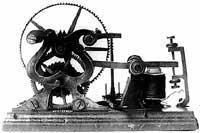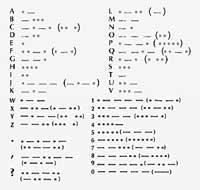Telegraph of Morse: Invention sent by God

Newly arrived from the United States to London, the young Morse wrote a letter to his mother. The letter said approximately: “Dear Amatxu, I would like you to know that I have arrived well, but among us there are 3,000 miles and they will spend several weeks before you know.”
Mors was 20 years old when he wrote these words and perhaps at that time he had a desire to send the words hanging in the air instead of by boat. In any case, in the letters written about 30 years later, I would not have to show that discontent. By then he had invented the telegraph. Morse himself telegraphed the first message sent by cable in 1844.
Inventor painting portraits
F. Samuel B. Morse was born in Charleston, in the North American state of Massachusetts. He studied at Yale University. There he studied electricity among other topics. But at that time, even though his parents were against him, they liked painting the most. In the end, when he finished college, his parents sent him to London to learn how to paint. In 1815 he returned to the United States and spent his life painting small portraits. Around 1825 he was a great portraitist in New York. At that time, although he had little money in his pocket, he was a friend of the most important and intellectual characters in the city.
In 1832, after a trip to Europe, Ampère discovered the results of his research on electromagnetism. And it seems that the idea of the telegraph got rid of the conversation of that boat. Surely he had already made the first draft of the telegraph for 1835. However, he painted most of the time, taught art and devoted it to politics. Around 1837, however, he focused on invention.

That year he applied for the American Electromagnetic Telegraph patent. By 1838 he invented a code of points and scripts. In 1843, with the collaboration of a congressman, he managed to present and approve a bill. According to the decision adopted in Congress, 30,000 dollars would be destined to build a telegraphic line between Washington and Baltimore. And they did. By 1844 a line of 60 kilometers had been built. On May 24 of the same year, Mors himself sent the first message: “What has God sent us?” Since then, Mors lived years full of money and glory. In 1871, in a public act, he sat before a telegraph table and sent his last greeting. He died in 1872.
Electromagnets attracted by messages
Morse's telegraph base is very simple. A closed electrical circuit is placed between two telegraphic stations using cables supported on poles. Simply place a single cable, as both stations can be connected to the ground. On the other hand, to close and expand the circuit, in each station there is a single-key switch. In addition, there is a device that works as a receiver. This receiver has an electromagnet and the electromagnet has a needle at one end. Finally, there is a paper tape that rotates slowly through a clock mechanism. For sending messages from one station to another, electric pulses based on the Morse code are sent through the cable.
By pressing the switch key of one station and closing the circuit, the electrical current circulating through the cable attracts one end of the electromagnet of the other station and the needle located on the other side hits against the paper tape. By pressing the key for a short period of time, the needle marks a point on the paper; if we tread it for a longer time marks a stripe. Combining points and lines, Mors invented the alphabet that bears his name. Later, in 1856, the sound key was invented. Through this system, telegraphers could listen to the “said” keys and write the message directly on paper.
Morse code

But the system devised by Mors had to overcome a problem as soon as it reached Europe. In fact, most languages in this part of the Atlantic use diacritical signs (accentuations, diuresis, etc. ). ). For this reason, a conference of European Nations in 1851 invented the so-called Morse International Code or Morse Continental Code.
Despite the codes, the telegraph caused several changes in the nineteenth century. In 20th century society. For example, many women began working as telegraphers, which allowed them to work worthily outside the home. In addition, a special subculture was created around the telegraph, similar to that currently occurring in the Internet environment.
XIX. From the end of the 20th century, however, the success of Morse's telegraph began to weaken. He was followed by telephones, telephones and so on, excluding the initial telegraph. However, the Morse code survived thanks to the wireless telegraph. Since then, the sea has been the place where the Morse code has been used the most. But at sea radio and satellites have also prevailed, so from now on the life of the Morse code will remain entirely in the hands of radio amateurs.





